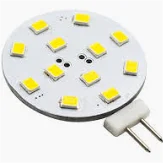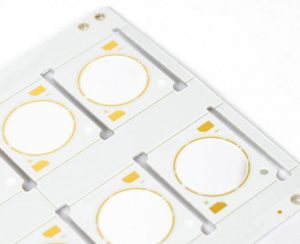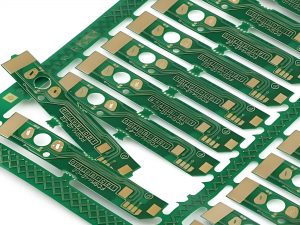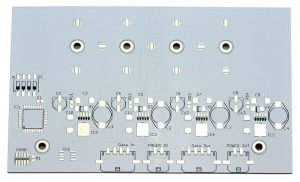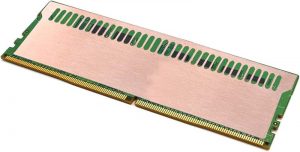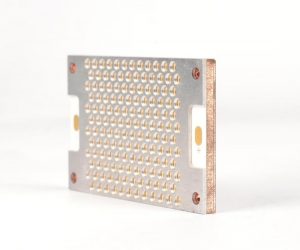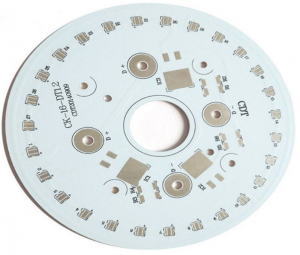As a new type of PCB material, aluminum base pcb board is gradually becoming a popular choice in the electronics field with its excellent performance and wide application fields.
What is aluminum base material PCB?
Aluminum base material PCB (Printed Circuit Board) refers to a special type of PCB that uses aluminum as the substrate material. This PCB usually includes three main parts:
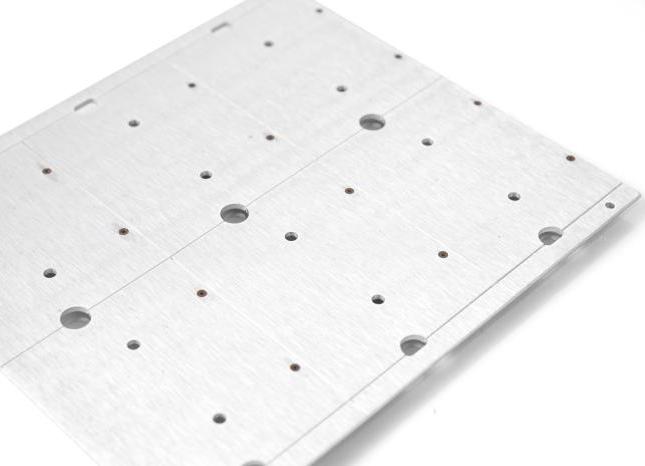
- 1. Circuit layer: This is the part where the circuit pattern is installed, usually a layer of copper foil, which is etched to form a circuit path.
- 2. Insulating thermal conductive layer: Located between the circuit layer and the metal base layer, this layer of material not only needs to provide electrical insulation between circuits, but also has good thermal conductivity to transfer the heat generated when the circuit is working to the metal base layer.
- 3. Metal base layer: Usually a layer of aluminum plate, its function is to quickly dissipate the heat from the circuit layer.
Due to its good thermal conductivity, aluminum base PCB is very popular in application scenarios that require efficient heat dissipation, in LED lighting, power management, automotive electronics, communication equipment, and other electronic devices that require high power output and good thermal management.
Compared with traditional FR-4 fiberglass PCBs, aluminum base pcb boards can manage heat more effectively, thereby improving the reliability and life of electronic components.
Why Aluminum is used in PCB?
There are several main reasons for using aluminum in PCBs (printed circuit boards):
1. Good heat dissipation performance
- High thermal conductivity: Aluminum is an excellent thermal conductive material with a relatively high thermal conductivity. During the operation of the PCB, electronic components will generate heat, and the aluminum substrate can quickly conduct this heat away to avoid damage to electronic components caused by excessive local temperatures, thereby improving the stability and reliability of electronic equipment and extending the service life of components.
- Uniform heat dissipation: The aluminum substrate can evenly distribute heat across the entire PCB, prevent hot spots from concentrating, and reduce the risk of failures caused by local overheating.
2. Higher mechanical strength
- Vibration resistance: Aluminum has a certain rigidity and toughness, and can withstand the vibration and impact that electronic equipment may be subjected to during use, which can ensure that the PCB will not be easily damaged by external forces.
- Dimensional stability: The dimensional changes of aluminum substrates are relatively small under different temperature and humidity conditions, which can maintain the structural stability of PCBs and ensure the welding reliability of electronic components.
3. Good insulation performance
- The surface of the specially treated aluminum substrate has a good insulation layer, which can effectively prevent circuit short circuits and leakage. At the same time, the insulation layer can also withstand a certain voltage to meet the electrical insulation requirements of different electronic equipment.
- Good compatibility with other insulating materials: It can be well combined with the packaging materials and welding materials of various electronic components to ensure the overall performance of electronic equipment.
4. Good processing performance
- Strong processability: Aluminum substrates can be made using traditional PCB processing techniques, such as etching, drilling, cutting, etc., which is convenient and fast and can meet different design requirements.
- Surface processability: The surface of the aluminum substrate can be processed in a variety of ways, such as copper plating, gold plating, tin spraying, etc., to improve welding performance and corrosion resistance.
5. Cost-effectiveness
- Relatively low material cost: Aluminum is a common metal material with abundant resources and relatively stable prices. Compared with some high-performance heat dissipation materials, the cost of aluminum substrates is low, which can reduce the manufacturing cost of electronic equipment while ensuring performance.
- High production efficiency: Due to the good processing performance of aluminum substrates, large-scale automated production can be achieved, which can improve production efficiency and further reduce costs.
How to choose aluminum base pcb board?
Choosing the right aluminum base pcb board is crucial to the performance and reliability of electronic equipment. In the selection process, multiple factors need to be considered, including glass transition temperature, heat resistance, flatness, thermal expansion coefficient and electrical performance.
(I) Glass transition temperature
Glass transition temperature (Tg) is one of the important parameters for measuring the heat resistance of PCB substrates. Generally speaking, substrates with higher Tg are more stable in high temperature environments and are not prone to deformation or damage.
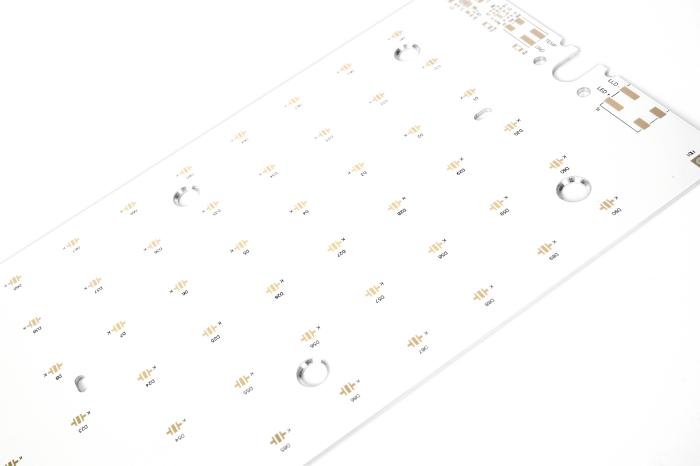
For application scenarios with higher operating temperatures, aluminum base pcb boards with Tg higher than the circuit operating temperature should be selected. The Tg of the current mainstream FR-4 board is about 130-140 degrees. If the circuit operating temperature is close to or exceeds this value, it is necessary to consider choosing an aluminum substrate material with a higher Tg.
(II) Heat resistance
Aluminum-based PCB boards should have high heat resistance to ensure that they can still work normally in high temperature environments.
Generally, a heat resistance of 250℃/50S is required. This means that the board will not undergo significant performance changes under short-term high temperature exposure.
(III) Flatness
In SMT (surface mount technology), it is required to use boards with a small degree of curvature as much as possible. Aluminum base PCB boards with good flatness can ensure accurate installation of components and good welding quality. If the flatness of the board is poor, it may cause the components to be installed loosely, and even cause problems such as cold soldering and short circuits during the welding process.
(IV) Thermal expansion coefficient
The thermal expansion coefficient (CTE) is one of the key factors to consider when selecting aluminum base pcb boards. Due to the inconsistent thermal expansion coefficient in the thickness direction, it is easy to cause PCB deformation, and in severe cases, it will cause the metallized holes to break, resulting in damage to components.
The thermal expansion coefficient of the aluminum substrate is 50×10⁻⁶cm/cm℃, which is smaller than that of the general FR-4 board and closer to the thermal expansion coefficient of copper foil. When selecting, try to choose a board with a low thermal expansion coefficient and matching other components to reduce the thermal stress caused by the difference in thermal expansion coefficient.
(V) Electrical performance
For high-frequency circuits, materials with high dielectric constant and low dielectric loss are required. Insulation resistance, withstand voltage strength, and arc resistance must meet product requirements.
In communication electronic equipment, high-frequency amplifiers, filters and other circuits have high requirements for electrical performance, and aluminum base pcb boards with good electrical performance need to be selected to ensure accurate signal transmission and stability.
In summary, according to application requirements, factors such as glass transition temperature, heat resistance, flatness, thermal expansion coefficient and electrical performance can be comprehensively considered to select a suitable aluminum base pcb board to ensure the performance and reliability of electronic equipment.
Which is a major disadvantage of aluminum?
Although aluminum has many advantages, it also has some inherent disadvantages as a material that may limit its use in certain applications.
- 1. Lower conductivity than copper: Although aluminum has a relatively high conductivity, it is still lower than copper.
- 2. Easy to deform: Aluminum has a relatively low hardness, so it is more likely to undergo plastic deformation when subjected to external forces.
- 3. Cold flow phenomenon: Aluminum becomes more brittle at low temperatures, and may exhibit cold flow (creep) phenomenon in high temperature environments, that is, slow deformation under constant load.
- 4. Difficult welding: The surface of aluminum is prone to form an oxide film, which affects the quality of welding and makes aluminum welding more difficult than other metals.
- 5. Corrosion resistance condition restrictions: Although aluminum itself has a certain degree of corrosion resistance, aluminum may accelerate corrosion in certain specific environments, such as salt water, alkaline solutions or halogens.
- 6. Connection reliability: When aluminum is in direct contact with other metals such as copper, corrosion problems may occur in some cases due to electrochemical reactions, especially in humid environments, which may affect the long-term reliability of the connector.
- 7. Large thermal expansion coefficient: Aluminum has a relatively high thermal expansion coefficient, which means that in an environment with large temperature changes, aluminum products may change in size due to thermal expansion and contraction, which may cause problems for applications that require precise matching.
What is the dielectric layer of aluminum PCB?
The dielectric layer of aluminum PCB is an insulating layer, which is located between the circuit layer and the metal layer and plays a role of isolation and insulation.
This insulating layer uses a thermally conductive insulating material that can quickly transfer the heat generated by the LED to the aluminum substrate. At the same time, the thermal resistance of this thermally conductive insulating material is a key factor that affects the efficiency of heat transfer.

In the design of aluminum substrates, the insulating layer is an indispensable part, which ensures the normal operation of the circuit while allowing heat to be effectively transferred to the aluminum base layer, thereby improving the thermal and mechanical properties of the entire structure.
Why don’t we use aluminum instead of copper?
The main reasons for not using aluminum instead of copper in PCBs (printed circuit boards) include the following:
- Conductivity difference: Copper has significantly better conductivity than aluminum. This means that in circuits that require good conductivity, using copper can provide more stable current transmission.
- Thermal conductivity difference: Copper substrates have higher thermal conductivity than aluminum substrates, which means that copper performs better in transmission efficiency, heat dissipation, and service life.
- Resistance difference: Since copper has a higher density than aluminum, copper generally has lower resistance than aluminum. Using copper can reduce power loss and improve power transmission efficiency.
- Weight difference: Copper has a higher density per unit area, resulting in copper PCBs weighing much more than aluminum PCBs under the same design. But if weight is not the main consideration, copper is widely used for its excellent electrical properties.
- Production process: The production process of aluminum substrate PCBs is relatively simple, but this does not mean that aluminum is a better choice. In some cases, although aluminum substrates may be produced faster, copper substrates are preferred in many applications due to their superior electrical properties.
In summary, although aluminum as a lightweight, low-cost material may have advantages in some cases, copper is still the preferred material in PCB manufacturing due to its better electrical conductivity, thermal conductivity, low resistance and applicability in most applications.
In short, as a new type of PCB material, aluminum base pcb board has the advantages of excellent heat dissipation, high mechanical strength, good electrical properties and environmental protection and recyclability. With the continuous development and progress of electronic technology, market demand will continue to increase. BEST Technoloby, as a professional aluminum substrate manufacturer, has rich manufacturing experience. The aluminum substrates produced have been tested by the market for a long time, and the service quality is in the first echelon. Choose us and you will get the best experience.
Tags: aluminum base pcb board, aluminum pcb, Aluminum Printed Circuit Board, PCB


